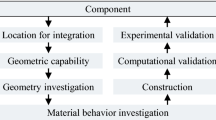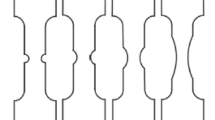Abstract
To allow for a safe design of metallic structures, it must be considered that, as a result of the manufacturing and processing operations, cracks or flaws below the NDI (Non-Destructive Inspection) detectability level always exist in the component after inspection. Further problems originate from the defect geometry. Failure of engineering structural components and structures have been mostly traced to surface cracks. Especially for a surface crack containing structure that is thin, the limit collapse of a ligament is usually the main cause of structure rupture. Study of the evaluation procedure relating to the limit load of the surface crack ligament is, therefore, an important project for conventional fracture assessment, particularly for pressure vessel (LBB) assessment. For this purpose, novel more accurate residual strength prediction method based on the Elasto-Plastic Fracture Mechanics (EPFM) has been developed and tested. Laboratory tests on tensile plate specimens with surface cracks were performed considering two different materials. In the final part of the work, effort was directed toward the verification and justification of selected analytical methods by adequate component testing. The most significant results of this work deal with residual strength evaluation for the thin wall pressure containing components. The important finding is that there is a potential for improvement in comparison to the current methods that may be used to increase payoff of the lightweight structures. The presented very robust analysis method and the useful structure integrity evaluation procedure should significantly contribute to the state-of-the-art structure optimisation and being applied to the design of the light-weight structures should ease the effort of the structure engineer to develop the successful and reliable hardware and to keep in place with advancing technologies.
Similar content being viewed by others
References
Agatonovic, P. (1987). Inelastic strain and creep fatigue life prediction for tubular component details using numerical simulation. Creep and Fracture of Engineering Materials and Structures (Edited by B. Wilshire and R.W. Evans), Proceeding of the 3rd International Conference Swansea, U.K., The Institute of Metals, London.
Agatonovic, P. and Windisch, M. (1990). Nonlinear fracture analysis of specimens and components with surface cracks. Numerical Methods in Fracture Mechanics (Edited by A.R. Luxmoore) Peneridge Press Limited, Swansea, 597–610.
Agatonovic, P. and Windisch, M. (1990). Anwendung kleiner proben mit oberflächeriß zur vorhersage der tragfähigkeit von rißbehafteten bauteilen. Vorträge der Tagung DVM Werkstoffprüfung 250, 597–610.
Agatonovic, P. and Windisch, M. (1991). Role of combined numerical and experimental investigation in the justification of the structural integrity and damage tolerance of space structures. Procedure of International Conference of Spacecraft Structures and Mechanical Testing, ESA SP-321, Noordwijk, The Netherlands, 679–685.
Agatonovic, P. and Henriksen, T.K. (1996). Development of residual strength prediction tools for the structure integrity of launchers based on elasto-plastic fracture mechanics. Procedure of Conference on Spacecraft Structures, Materials and Mechanical Testing, Noordwijk, The Netherlands (ESA SP-386), pp. 389–398.
Agatonovic, P., Kordisch, H. and Sommer, E. (1989). Justification of dimensioning criteria for a rocket motor case using fracture mechanics. Element of Defect Assessment, European Symposium on EPFM, Freiburg.
ASTM-E-740. Standard practice for fracture testing with surface-crack tension specimens.
ESA Contract 9934/92 (1995). Final Report, MAN Technologie AG.
Landes, J.D. (1994). The effect of constraints on fracture safe design. ECF10-Structural Integrity: Experiments, Model and Application, pp. 23–35.
Milne, I. et al. (1988). Assessment of the integrity of structures containing defects. International Journal of Pressure Vessels and Piping 32, 3–104.
Newman, J.C. and Raju, I.S. (1983). Stress-intensity factor equation for cracks in three-dimensional finite bodies. ASTM STP 791, pp. I-238–I-265.
Oberparleiter, W. and Agatonovic, P. (1986). Creep crack growth and fatigue crack propagation of IN 800 H at 830 C. Fracture Control of Engineering Structures (Edited by H.C. van Elst and A. Bakker), Proceedings 6th Bienal European Conference on Fracture (ECF6) in Amsterdam (Holland).
Read D.T. and McHenry, H.I. (1990). Postweld heat treatment criteria for repair welds in 2.25 Cr-1Mo Superheater headers. The Application of Fracture Mechanics to Life Estimation of Power Plant Components (Edited by S. Sedmak), EMAS.
Sih, G.C. (1985). Mechanics and physics of energy density theory. Theoretical and Applied Fracture Mechanics 4, 157–173.
Zarzour, J.F. et al. (1993). Loss of Crack-Tip Constraints for Shallow Cracks in Bending, JMEPEG 2(6), 867–872.
Author information
Authors and Affiliations
Rights and permissions
About this article
Cite this article
Agatonovic, P. Development of residual strength evaluation tool based on stress-strain approximation. International Journal of Fracture 88, 129–152 (1997). https://doi.org/10.1023/A:1007415507989
Issue Date:
DOI: https://doi.org/10.1023/A:1007415507989




